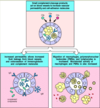Innate Immunity Flashcards
What is the primary concern of the immune system? What is immunology?
- principally concerned with the maintenance of homeostasis
- immunology: the study of multi-layered host defence system that protects us against: pathogens, tumours, toxins, prions, allergens, etc.
What are some examples of viruses?
- variola; smallpox
- influenza; the flu
- HIV; AIDS
**test
What are some examples of bacteria?
- salmonella enteritidis; food poisoning
- mycobacterium tuberculosis; tuberculosis
**test
What are some examples of fungi?
- epidermophyton floccosum; ringworm
- candida albicans; thrush, systemic candidiasis
What are examples of parasites?

What did Edward Jenner observe during the small pox outbreak?
- milkmaids exposed to cow pox (similar virus) didn’t seem to come down with small pox
- he postulated that being exposed to something related protected you from getting sick
- coined the word vaccination; took us from small pox epidemic to it being eradicated
- small pox has no natural reservoirs so through sustained vaccination it has been eradicated

Describe the multi-layered nature of the immune system
- intrinsic barriers are first thing for bacteria/virus to encounter; if it works, it doesn’t get in
- if it does innate (immediate) immunity is activated upon arrival; uses preformed non specific effectors to kill the intruder
- if these fail, an early induced innate response occurs (inflammation); threat is recognized and more cells/protein will be recruited from blood to try to get rid of intruder
- if this fails, adaptive immune response ensues; takes time because it takes parts of the intruder to the lymph node, it is recognized by B and T cells then these cells mature, then goes back to where infection is to wipe it out

What are the characteristics of the 3 layers of immunity?
Intrinsic barriers: pre formed barriers to prevent invasion
Innate immunity: non-specific, fast, fixed/constant
Adaptive immunity: very specific, slow, improves throughout response
What are examples of intrinsic barriers?
Mechanical: expulsive force (coughing, sneezing, defecation, urination), ciliary beating (move mucus north into stomach), tight junctions in epithelium
Chemical: low pH barriers (stomach, vagina, sebaceous fatty acids) where bacteria mostly can’t survive, proteolytic enzymes (lysozyme and pepsin in tears and gut)
Physiological: temperature regulation (makes it a hostile environment for things to survive- if it manages to survive at 37 then we have a fever and raise body temp even more to try to kill it)
Microbiological: commensal flora compete with pathogens (more of these cells in GI tract than mammalian cells)
What is complement? How is it activated?
- resident defence 1
- complement acts locally
- exist as precursor (zymogen) proteins throughout the body
- proteins made in liver and are in blood
- zymogen gets activated when they are cleaved
- antibody-pathogen binding can activate zymogen; body will produce antibodies against an antigen and binding to that antigen will trigger cleavage of zymogen
- lectin-mannose binding: lectins are produced in body and bind to specific conformations of sugar, we don’t produce the same mannose as bacteria, lectin can recognize the bacterial mannose and bind to it which causes complement proteins to be cleaved
- some pathogens have enzymatic activity on their surface and some of these enzymes can cleave the zymogens (some have intrinsic complement cleaving activity)
How do complement contribute to inflammation?
- once activated, complement cleavage products:
- bind to receptors on inside of BVs and cause them to dilate, increase vascular permeability, and cell-adhesion molecules and cause
- capillary membranes to become leaky allowing proteins and fluid to leak out of the blood and extravasation of immunoglobin and complement molecules
- endothelium of BV expresses molecules that drag WBCs from circulation into the tissue; migration of macrophages, polymorphonuclear leukocytes (PMNs) and lymphocytes increases
- microbicidal activity of macrophages and PMNs is increased
2. Membrane attack complex formation:

How do complement contribute to membrane attack complex formation?
- complement is activated
- complement can make holes in bacterial cell wall by forming polymerized barrel shaped assemblies
- what is inside the bacterium leaks out (DNA, RNA, enzymes)
- kills bacteria

How do complement relate to opsonization?
- activated complement coat surface of pathogen with sticky molecules so that when a macrophage or other WBC comes along it recognizes that it is a bacteria that has been tagged for death
- causes the cell to phagocytose the bacterium and kill it

What are resident phagocytes?
- resident defence 2
- directly under the surface of our body (skin, resp/urogenital/GI tract, mucosal membranes) are macrophages that are waiting for something to arrive
- dendritic cells also here
- neutrophils are there but are not resident phagocytes; they are recruited later after an inflammation and are never present in normal tissue
- cause third part of immune response

What is the activation of inflammation during the immune response?
- pattern recognition receptors (PRR): molecules that are expressed on the surface of our cells and recognize a pathogen (recognizes pathogen from PAMPs)
- pathogen-associated molecular patterns (PAMPs): on surface/inside of the pathogen, broadly conserved molecular pattern that is constant and absolutely required by a pathogen
- PRR include toll-like receptors (TLRs)
- TLRs are numbered 1-12 and each recognizes something very specific (specific PAMP) that a pathogen can not live without
- TLR-1 recognizes peptidoglycan which is an essential part of bacterial cell walls and is not produced in any cell of the body; any peptidoglycan in the body indicates 100% of the time it is foreign
- TLR 3 recognizes double stranded RNA; no point in our life cycle that we make double RNA but double RNA is made by viruses all the time
- TLR 4 recognizes LPS needed by gram negative bacteria
- TLR 5 recognizes flagellin which is the protein that makes whip like flagella of motile bacteria
- TLR 9 recognizes unmethylated CpG DNA is common in bacteria to protect themselves against viruses
- none of these things are ever made by mammalian cells





